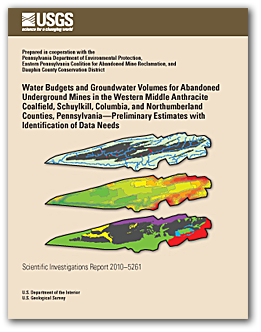Scientific Investigations Report 2010–5261
ABSTRACT
This report, prepared in cooperation with the Pennsylvania Department of Environmental Protection (PaDEP), the Eastern Pennsylvania Coalition for Abandoned Mine Reclamation, and the Dauphin County Conservation District, provides estimates of water budgets and groundwater volumes stored in abandoned underground mines in the Western Middle Anthracite Coalfield, which encompasses an area of 120 square miles in eastern Pennsylvania. The estimates are based on preliminary simulations using a groundwater-flow model and an associated geographic information system that integrates data on the mining features, hydrogeology, and streamflow in the study area. The Mahanoy and Shamokin Creek Basins were the focus of the study because these basins exhibit extensive hydrologic effects and water-quality degradation from the abandoned mines in their headwaters in the Western Middle Anthracite Coalfield. Proposed groundwater withdrawals from the flooded parts of the mines and stream-channel modifications in selected areas have the potential for altering the distribution of groundwater and the interaction between the groundwater and streams in the area. Preliminary three-dimensional, steady-state simulations of groundwater flow by the use of MODFLOW are presented to summarize information on the exchange of groundwater among adjacent mines and to help guide the management of ongoing data collection, reclamation activities, and water-use planning. The conceptual model includes high-permeability mine voids that are connected vertically and horizontally within multicolliery units (MCUs). MCUs were identified on the basis of mine maps, locations of mine discharges, and groundwater levels in the mines measured by PaDEP. The locations and integrity of mine barriers were determined from mine maps and groundwater levels. The permeability of intact barriers is low, reflecting the hydraulic characteristics of unmined host rock and coal. A steady-state model was calibrated to measured groundwater levels and stream base flow, the latter at many locations composed primarily of discharge from mines. Automatic parameter estimation used MODFLOW-2000 with manual adjustments to constrain parameter values to realistic ranges. The calibrated model supports the conceptual model of high-permeability MCUs separated by low-permeability barriers and streamflow losses and gains associated with mine infiltration and discharge. The simulated groundwater levels illustrate low groundwater gradients within an MCU and abrupt changes in water levels between MCUs. The preliminary model results indicate that the primary result of increased pumping from the mine would be reduced discharge from the mine to streams near the pumping wells. The intact barriers limit the spatial extent of mine dewatering. Considering the simulated groundwater levels, depth of mining, and assumed bulk porosity of 11 or 40 percent for the mined seams, the water volume in storage in the mines of the Western Middle Anthracite Coalfield was estimated to range from 60 to 220 billion gallons, respectively. Details of the groundwater-level distribution and the rates of some mine discharges are not simulated well using the preliminary model. Use of the model results should be limited to evaluation of the conceptual model and its simulation using porous-media flow methods, overall water budgets for the Western Middle Anthracite Coalfield, and approximate storage volumes. Model results should not be considered accurate for detailed simulation of flow within a single MCU or individual flooded mine. Although improvements in the model calibration were possible by introducing spatial variability in permeability parameters and adjusting barrier properties, more detailed parameterizations have increased uncertainty because of the limited data set. The preliminary identification of data needs includes continuous streamflow, mine discharge rate, and groundwater levels in the mines and adjacent areas. Data collected when the system is responding to hydrologic stresses such as recharge or pumping changes would provide information on hydraulic barrier integrity and groundwater/surface-water exchanges; the latter would also be informed by tracer studies and streambed surveys. Use of transient simulations, calibrated with transient measurements, is suggested to provide an independent estimate of the storage capacity of the mines. |
First posted March 8, 2011 For additional information, visit: or contact: Part or all of this report is presented in Portable Document Format (PDF); the latest version of Adobe Reader or similar software is required to view it. Download the latest version of Adobe Reader, free of charge. |
Goode, D.J., Cravotta, C.A., III, Hornberger, R.J., Hewitt, M.A., Hughes, R.E., Koury., D.J., and Eicholtz, L.W., 2011, Water budgets and groundwater volumes for abandoned underground mines in the Western Middle Anthracite Coalfield, Schuylkill, Columbia, and Northumberland Counties, Pennsylvania—Preliminary estimates with identification of data needs: U.S. Geological Survey Scientific Investigations Report 2010–5261, 54 p.
Abstract
Introduction
Purpose and Scope
Previous Investigations
Hydrogeologic Setting
Streamflow and Groundwater Relations
Streamflow and Mine-Discharge Data
Mine-Pool Water-Level Data
Multicolliery Unit Concept
Simulated Water Budgets and Effects of Pumping Changes
Conceptual Model
Model Development
Computer Code and Grid
Boundary Conditions
Recharge from Precipitation
Streams
Coal Mines
Wells
Aquifer Properties
Model Adjustments
Weighting of Measurements
Adjusted Model Parameters
Preliminary Results of Model Simulations
Current Conditions
Increased Pumping in Gilberton Area
Example of Additional Model Adjustments
Limitations of the Preliminary Model Results
Estimated Groundwater Volume and Distribution
Uncertainty in Estimates of Mine-Pool Volume
Alternative Method for Determining Volume
Identification of Data Needs
Summary
References Cited